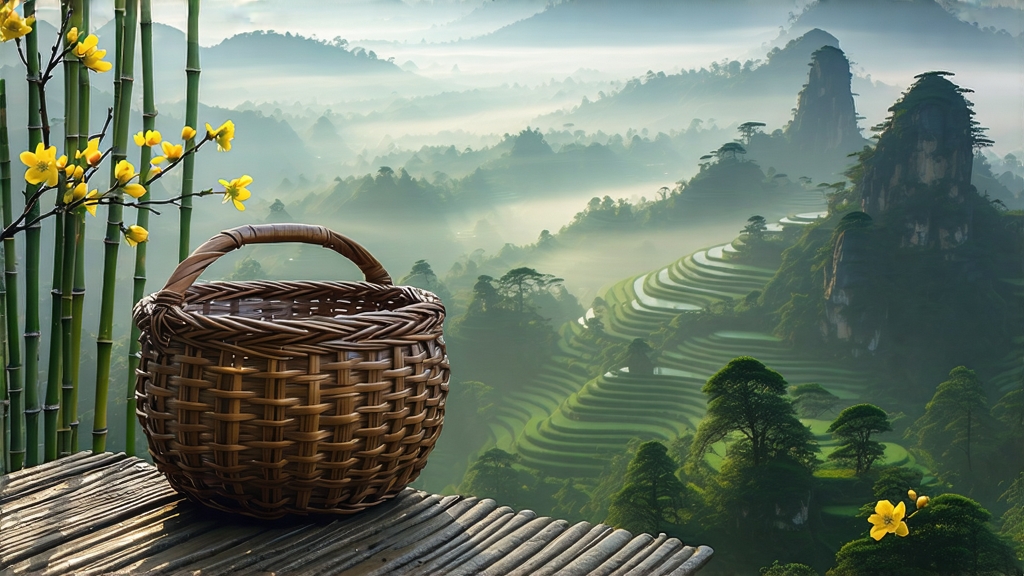
Tucked high on the mist-crowned peaks of Sichuan’s Meng Ding mountain, where clouds brush the evergreen crowns and the Min River glints far below, grows one of China’s most discreet aristocrats of tea: Meng Ding Huang Ya, the “Yellow Bud from the Summit of Meng.” Unlike its better-known green cousin Meng Ding Gan Lu, Huang Ya has always preferred the quiet company of scholars and emperors to the clamor of the marketplace. For more than twelve centuries it was carried in silk-lined caddies down the mountain trails to Chang’an, the Tang capital, where it was presented to the throne as “the tea that drinks like a sunrise.” Today, only a few thousand kilos leave the mountain each spring, most destined for private cellars in Beijing, Tokyo, and, increasingly, the cabinets of curious tea lovers in Berlin and Vancouver who have learned that patience is the price of its subtle honeyed glow.
History: from alchemy to accolade
The first written record appears in 808 CE, when the monk Shi Ju of the Meng Ding Temple offered “yellow sprouts picked before the Qingming rain” to Emperor Xianzong. The court chronicler noted that the infusion “turned the porcelain the color of young amber and carried the scent of winter plum.” During the Song dynasty the tea was listed among the fourteen “imperial plantings,” and Ming tax registers show that 22.4 dan (about 1,350 kg) were exacted annually as tribute. Legend claims that the tea’s yellow tinge was discovered by accident: a lazy monk left freshly killed-green leaves under a bamboo mat for two days; when he returned the edges had turned primrose and the liquor had lost all grassiness, gaining instead a rounded sweetness that reminded him of boiled chestnuts. Whether myth or mnemonic, the story captures the essence of yellow tea: a controlled, gentle re-oxidation that borrows time from the calendar and trades it for fragrance.
Micro-terroir: why the mountain matters
Meng Ding sits at 29.9° N, 1,450 m above sea level, straddling the edge of the Sichuan basin and the Tibetan plateau. The slope faces east, catching the first light, but is shielded from the harsh afternoon sun by a horseshoe ridge. Annual rainfall exceeds 1,800 mm, yet the porous granite sub-soil drains quickly, forcing roots to dive deep for minerals. The result is a leaf that is physiologically thick yet chemically delicate: amino acids run high (responsible for sweetness), while catechins and caffeine stay moderate, giving a soft, sustained lift rather than a jolt. Local farmers still divide the mountain into five micro-zones; Huang Ya for tribute must come from the uppermost, known as Shangqing Peak, where wild osmanthus trees interplant the tea gardens, their October bloom drifting into the soil and, some swear, re-emerging as a whisper of apricot in next April’s buds.
Plucking code: one bud, one leaf, before the insects wake
The harvest window opens on the first day the night temperature stays above 8 °C and closes as soon as the local wagtail begins to sing—usually less than ten days. Pickers work between 5:30 and 9:00 a.m., selecting only the standard “one bud and one unfolded leaf” measuring 2–2.5 cm. A skilled picker gathers barely 600 g per hour; 5 kg of fresh leaf are needed for 1 kg of finished tea. The pluck is immediately placed in shallow bamboo trays lined with goat-skin parchment, a practice said to prevent “mountain chill” from bruising the cells.
Craft: the secret of men huang – “sealed yellowing”
Yellow tea’s identity rests on a unique dual process: sha qing (kill-green) followed by men huang (literally “stuffing yellow”), a slow, humid re-warming that edges the leaf toward oxidation without ever crossing fully into black-tea territory.
- Sha Qing: Leaves are tumble-tossed in woks heated to 160 °C for 90 seconds, just enough to denature the oxidative enzymes on the surface. The master judges readiness by ear: when the crackle changes from popcorn to wet silk, it is time to exit.
- Initial Roll & Pre-dry: A light 5-minute rolling breaks cell walls; the leaf is then spread 2 cm thick on hemp cloth and baked at 70 °C until 55 % moisture remains.
3